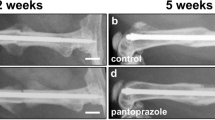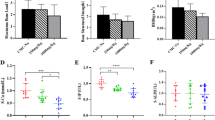Abstract
Proton pump inhibitors (PPIs), which are widely used in the treatment of dyspeptic problems, have been shown to reduce osteoclast activity. There is no information, however, on whether PPIs affect fracture healing. We therefore studied the effect of the PPI pantoprazole on callus formation and biomechanics during fracture repair. Bone healing was analyzed in a murine fracture model using radiological, biomechanical, histomorphometric, and protein biochemical analyses at 2 and 5 weeks after fracture. Twenty-one mice received 100 mg/kg body weight pantoprazole i.p. daily. Controls (n = 21) received equivalent amounts of vehicle. In pantoprazole-treated animals biomechanical analysis revealed a significantly reduced bending stiffness at 5 weeks after fracture compared to controls. This was associated with a significantly lower amount of bony tissue within the callus and higher amounts of cartilaginous and fibrous tissue. Western blot analysis showed reduced expression of the bone formation markers bone morphogenetic protein (BMP)-2, BMP-4, and cysteine-rich protein (CYR61). In addition, significantly lower expression of proliferating cell nuclear antigen indicated reduced cell proliferation after pantoprazole treatment. Of interest, the reduced expression of bone formation markers was associated with a significantly diminished expression of RANKL, indicating osteoclast inhibition. Pantoprazole delays fracture healing by affecting both bone formation and bone remodeling.





Similar content being viewed by others
References
Ferron GM, McKeand W, Mayer PR (2001) Pharmacodynamic modeling of pantoprazole’s irreversible effect on gastric acid secretion in humans and rats. J Clin Pharmacol 41:149–156
Lindberg P, Nordberg P, Alminger T et al (1986) The mechanism of action of the gastric acid secretion inhibitor omeprazole. J Med Chem 29:1327–1329
Graziani G, Como G, Badalamenti S et al (1995) Effect of gastric acid secretion on intestinal phosphate and calcium absorption in normal subjects. Nephrol Dial Transplant 10:1376–1380
O’Connell MB, Madden DM, Murray AM et al (2005) Effects of proton pump inhibitors on calcium carbonate absorption in women: a randomized crossover trial. Am J Med 118:778–781
Targownik LE, Lix LM, Metge CJ et al (2008) Use of proton pump inhibitors and risk of osteoporosis-related fractures. CMAJ 179:319–326
Yang YX, Lewis JD, Epstein S, Metz DC (2006) Long-term proton pump inhibitor therapy and risk of hip fracture. JAMA 296:2947–2953
Yu EW, Blackwell T, Ensrud KE et al (2008) Acid-suppressive medications and risk of bone loss and fracture in older adults. Calcif Tissue Int 83:251–259
Tucker KL, Hannan MT, Qiao N et al (2005) Low plasma vitamin B12 is associated with lower BMD: the Framingham Osteoporosis Study. J Bone Miner Res 20:152–158
Farina C, Gagliardi S (2002) Selective inhibition of osteoclast vacuolar H+-ATPase. Curr Pharm Des 8:2033–2048
Tuukkanen J, Väänänen HK (1986) Omeprazole, a specific inhibitor of H+-K+-ATPase, inhibits bone resorption in vitro. Calcif Tissue Int 38:123–125
Mizunashi K, Furukawa Y, Katano K, Abe K (1993) Effect of omeprazole, an inhibitor of H+,K+-ATPase, on bone resorption in humans. Calcif Tissue Int 53:21–25
Visentin L, Dodds RA, Valente M et al (2000) A selective inhibitor of the osteoclastic V-H+-ATPase prevents bone loss in both thyroparathyroidectomized and ovariectomized rats. J Clin Invest 106:309–318
Bilic I, Zoricic I, Anic T et al (2001) Haloperidol-stomach lesions attenuation by pentadecapeptide BPC 157, omeprazole, bromocriptine, but not atropine, lansoprazole, pantoprazole, ranitidine, cimetidine and misoprostol in mice. Life Sci 68:1905–1912
Masubuchi N, Hakusui H, Okazaki O (1997) Effects of pantoprazole on xenobiotic metabolizing enzymes in rat liver microsomes: a comparison with other proton pump inhibitors. Drug Metab Dispos 25:584–589
Holstein JH, Matthys R, Histing T et al (2008) Development of a stable closed femoral fracture model in mice. J Surg Res 153:71–75
Goldberg VM, Powell A, Shaffer JW et al (1985) Bone grafting: role of histocompatibility in transplantation. J Orthop Res 3:389–404
Histing T, Holstein JH, Garcia P et al (2009) Ex vivo analysis of rotational stiffness of different osteosynthesis techniques in mouse femur fracture. J Orthop Res 27:1152–1156
Gerstenfeld LC, Wronski TJ, Hollinger JO, Einhorn TA (2005) Application of histomorphometric methods to the study of bone repair. J Bone Miner Res 20:1715–1722
Mazziotti G, Canalis E, Giustina A (2010) Drug-induced osteoporosis: mechanisms and clinical implications. Am J Med 123:877–884
Zaidi M (1990) Modularity of osteoclast behaviour and “mode-specific” inhibition of osteoclast function. Biosci Rep 10:547–556
Sheraly AR, Lickorish D, Sarraf F, Davies JE (2009) Use of gastrointestinal proton pump inhibitors to regulate osteoclast-mediated resorption of calcium phosphate cements in vivo. Curr Drug Deliv 6:192–198
Karsdal MA, Henriksen K, Sørensen MG et al (2005) Acidification of the osteoclastic resorption compartment provides insight into the coupling of bone formation to bone resorption. Am J Pathol 166:467–476
Hyun JJ, Chun HJ, Keum B et al (2010) Effect of omeprazole on the expression of transcription factors in osteoclasts and osteoblasts. Int J Mol Med 26:877–883
Gerstenfeld LC, Sacks DJ, Pelis M et al (2009) Comparison of effects of the bisphosphonate alendronate versus the RANKL inhibitor denosumab on murine fracture healing. J Bone Miner Res 24:196–208
Marsell R, Einhorn TA (2009) The role of endogenous bone morphogenetic proteins in normal skeletal repair. Injury 40:4–7
Tsuji K, Bandyopadhyay A, Harfe BD et al (2006) BMP2 activity, although dispensable for bone formation, is required for the initiation of fracture healing. Nat Genet 38:1424–1429
Devlin RD, Du Z, Pereira RC et al (2003) Skeletal overexpression of noggin results in osteopenia and reduced bone formation. Endocrinology 144:1972–1978
Schütze N, Lechner A, Groll C et al (1998) The human analog of murine cystein rich protein 61 is a 1alpha,25-dihydroxyvitamin D3 responsive immediate early gene in human fetal osteoblasts: regulation by cytokines, growth factors, and serum. Endocrinology 139:1761–1770
Si W, Kang Q, Luu HH et al (2006) CCN1/Cyr61 is regulated by the canonical Wnt signal and plays an important role in Wnt3A-induced osteoblast differentiation of mesenchymal stem cells. Mol Cell Biol 26:2955–2964
Su JL, Chiou J, Tang CH et al (2010) CYR61 regulates BMP-2-dependent osteoblast differentiation through the αvβ3 integrin/integrin-linked kinase/ERK pathway. J Biol Chem 285:31325–31336
Hadjiargyrou M, Ahrens W, Rubin CT (2000) Temporal expression of the chondrogenic and angiogenic growth factor CYR61 during fracture repair. J Bone Miner Res 15:1014–1023
Crockett JC, Schütze N, Tosh D et al (2007) The matricellular protein CYR61 inhibits osteoclastogenesis by a mechanism independent of alphavbeta3 and alphavbeta5. Endocrinology 48:5761–5768
Schütze N, Kunzi-Rapp K, Wagemanns R et al (2005) Expression, purification, and functional testing of recombinant CYR61/CCN1. Protein Expr Purif 42:219–225
Conflict of interest
The authors have stated that they have no conflict of interest.
Author information
Authors and Affiliations
Corresponding author
Additional information
The first two authors contributed equally to this work.
Rights and permissions
About this article
Cite this article
Histing, T., Stenger, D., Scheuer, C. et al. Pantoprazole, a Proton Pump Inhibitor, Delays Fracture Healing in Mice. Calcif Tissue Int 90, 507–514 (2012). https://doi.org/10.1007/s00223-012-9601-x
Received:
Accepted:
Published:
Issue Date:
DOI: https://doi.org/10.1007/s00223-012-9601-x




